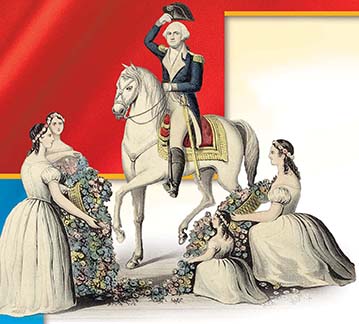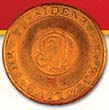SECTION 1: Government and Party Politics

▲ Women pay respect to the new President.

A button from Washington’s inauguration ►
WITNESS HISTORY  AUDIO
AUDIO
The First Inaugural
When George Washington gave his Inaugural Address in 1789, he was well aware of the extraordinary responsibility of leading “the experiment entrusted to the hands of the American people.” An official at the inauguration described the ceremony in a letter to his wife:
“It was with difficulty a passage could be made by the troops through the pressing crowds, who seemed to be incapable of being satisfied by gazing at this man of the people…. The streets were lined with the inhabitants as thick as the people could stand…. The houses were filled with gentlemen and ladies, the whole distance being half a mile, and the windows to the highest stories were illuminated by the sparkling eyes of innumberable companies of ladies, who seemed to vie with each other to show their joy on this great occasion.”
—Elias Boudinot, April 30, 1789
Objectives
- Describe the steps Washington’s administration took to build the federal government.
- Analyze Hamilton’s plans for the economy and the opposition to them.
- Explain how a two-party system emerged in the new nation.
Terms and People
- administration
- precedent
- Cabinet
- tariff
- loose construction
- strict construction
- Whiskey Rebellion
- political party
- Democratic Republican
NoteTaking
Reading Skill: Summarize Summarize information about the early American government in an outline like the one below.
- Building the Federal Government
- Electing Washington as President
- Forming the Cabinet
- Setting up the Judiciary
Why It Matters In 1789, the leaders of the new federal government of the United States gathered in New York City. Besides ideals, they had very little to guide them. The newly ratified Constitution was clear on some points but vague on others. It was also entirely untested. Those who had written the Constitution, along with the new President, George Washington, knew full well that a good start would secure the daring experiment in republican union. But early mistakes could doom it. Section Focus Question: How did debate over the role of government lead to the formation of political parties?
Building the Federal Government
The new government started out with huge problems. It had inherited a national debt of $52 million from the Confederation—a huge burden for a nation with a farm economy and only about 3 million people. With no navy and an army of only around 400 men, the United States was not respected by other countries. At New Orleans, the Spanish closed the Mississippi River to American trade. Along the Great Lakes, the British kept forts within American territory.
Electing a President
Fortunately, the new government enjoyed extraordinary leaders. In 1789, the new electoral college unanimously elected George Washington as President of the United States. As a revolutionary leader, Washington enjoyed widespread respect and popularity. Yet he took the difficult job reluctantly.




